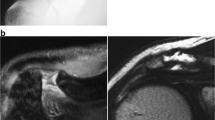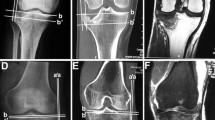Abstract
Objective
To identify MRI findings that can indicate chronic physeal stress injury and differentiate it from acute Salter-Harris (SH) fracture of the pediatric knee or wrist.
Methods
IRB-approved retrospective study of consecutively selected knee and wrist MRIs from 32 athletes with chronic physeal stress injury and 30 children with acute SH fracture. MRI characteristics (physeal patency, physeal thickening, physeal signal intensity (SI), continuity of the zone of provisional calcification (ZPC), integrity of the periosteum and/or perichondrium, pattern of periphyseal and soft tissue edema signal, and joint effusion) were compared.
Results
Forty-eight chronic physeal stress injuries (mean age 13.1 years [8.2–17.5 years]) and 35 SH fractures (mean age 13.3 years [5.1–16.0 years]) were included. Any physeal thickening was more common with chronic stress injury (98% vs 77%, p = 0.003). Abnormal physeal SI was more common with SH fractures (91% vs 67%, p = 0.008). ZPC discontinuity strongly suggested chronic stress injury (79% vs 49%, p < 0.004). Periosteal and/or perichondrial elevation or rupture and soft tissue edema characterized most of the acute SH fractures (p < 0.001) and were seen only in 1 chronic stress injury (< 2%). While periphyseal edema was not significantly different in the two groups (p = 0.890), a joint effusion was associated with acute SH fracture (p < 0.001).
Conclusion
Chronic physeal stress injury of the pediatric knee and wrist shows higher incidence of ZPC discontinuity and focal physeal thickening compared to SH fracture, reflecting disruption in normal endochondral ossification. However, these findings can overlap in the 2 groups. Periosteal and/or perichondrial injury, soft tissue edema signal, and joint effusion strongly suggest SH fracture and are rarely present with chronic stress injury.









Similar content being viewed by others
Data availability
Data were generated by the authors and available on request.
References
Rosendahl K, Strouse PJ. Sports injury of the pediatric musculoskeletal system. Radiol Med. 2016;121:431–41.
Arnold A, Thigpen CA, Beattie PF, Kissenberth MJ, Shanley E. Overuse physeal injuries in youth athletes. Sports Health. 2017;9:139–47.
Brian JM, Choi DH, Moore MM. The Primary Physis. Semin Musculoskelet Radiol. 2018;22:95–103.
Tsai A, McDonald AG, Rosenberg AE, Stamoulis C, Kleinman PK. Discordant radiologic and histological dimensions of the zone of provisional calcification in fetal piglets. Pediatr Radiol. 2013;43:1606–14.
Nguyen JC, Markhardt BK, Merrow AC, Dwek JR. Imaging of pediatric growth plate disturbances. Radiographics. 2017;37:1791–812.
Laor T, Jaramillo D. MR imaging insights into skeletal maturation: what is normal? Radiology. 2009;250:28–38.
Jaramillo D, Connolly SA, Mulkern RV, Shapiro F. Developing epiphysis: MR imaging characteristics and histologic correlation in the newborn lamb. Radiology. 1998;207:637–45.
Kraan RBJ, Kox LS, Oostra RJ, Kuijer PPFM, Maas M. The distal radial physis: exploring normal anatomy on MRI enables interpretation of stress related changes in young gymnasts. EJSS. 2020;20:1197–205.
Laor T, Wall EJ, Vu LP. Physeal widening in the knee due to stress injury in child athletes. AJR Am J Roentgenol. 2006;186:1260–4.
Apte SS, Kenwright J. Physeal distraction and cell proliferation in the growth plate. J Bone Joint Surg Br. 1994;76:837–43.
Nguyen JC, Sheehan SE, Davis KW, Gill KG. Sports and the growing musculoskeletal system: sports imaging series. Radiology. 2017;284:25–42.
Kwon S-W, Hong S-J, Nho J-H, Moon SI, Jung KJ. Physeal fracture in the wrist and hand due to stress injury in a child climber [Internet]. Medicine. 2018;e11571. https://doi.org/10.1097/md.0000000000011571.
Jaramillo D, Kammen BF, Shapiro F. Cartilaginous path of physeal fracture-separations: evaluation with MR imaging—an experimental study with histologic correlation in rabbits. Radiology. 2000;215:504–11.
Cepela DJ, Tartaglione JP, Dooley TP, Patel PN. Classifications in brief: Salter-Harris classification of pediatric physeal fractures. Clin Orthop Relat Res. 2016;474:2531–7.
Laor T, Hartman AL, Jaramillo D. Local physeal widening on MR imaging: an incidental finding suggesting prior metaphyseal insult. Pediatr Radiol. 1997;27:654–62.
Hosseinzadeh P, Milbrandt T. The normal and fractured physis: an anatomic and physiologic overview. J Pediatr Orthop B. 2016;25:385–92.
Rudicel S, Pelker RR, Lee KE, Ogden JA, Panjabi MM. Shear fractures through the capital femoral physis of the skeletally immature rabbit. J Pediatr Orthop. 1985;5:27–31.
Jónasson PS, Ekström L, Swärd A, Sansone M, Ahldén M, Karlsson J, et al. Strength of the porcine proximal femoral epiphyseal plate: the effect of different loading directions and the role of the perichondrial fibrocartilaginous complex and epiphyseal tubercle - an experimental biomechanical study. J Exp Orthop. 2014;1:4.
Author information
Authors and Affiliations
Corresponding author
Ethics declarations
Ethics approval
This study was approved by the institutional review board (IRB) at our hospital and was performed in compliance with the Health Insurance Portability and Accountability Act (HIPAA).
Additional information
Publisher's Note
Springer Nature remains neutral with regard to jurisdictional claims in published maps and institutional affiliations.
Rights and permissions
Springer Nature or its licensor (e.g. a society or other partner) holds exclusive rights to this article under a publishing agreement with the author(s) or other rightsholder(s); author self-archiving of the accepted manuscript version of this article is solely governed by the terms of such publishing agreement and applicable law.
About this article
Cite this article
Bedoya, M.A., Jaramillo, D., Iwasaka-Neder, J. et al. Stressed or fractured: MRI differentiating indicators of physeal injury. Skeletal Radiol (2024). https://doi.org/10.1007/s00256-024-04670-y
Received:
Revised:
Accepted:
Published:
DOI: https://doi.org/10.1007/s00256-024-04670-y




